
history
Intro
Whilst scouting has changed from the early days and foundations laid down by Baden-Powell, followed by Jack Barcham Green, we still follow the basic principles set out by our founders.
Times have changed and scouting has also changed, with many of the activities now available for members of the Scout Association which would not have been around at the beginning.
Enthusiasm & Effort
The last hundred years of Loose Swiss have only been possible due to the enthusiasm and efforts put into by a large number of leaders, supporters and parents. I hope that the generations that follow us over the next hundred years will have the same support to enable the young people, both boys and girls, to enjoy their time in Loose Swiss.
Paul Worden
Group Scout Leader
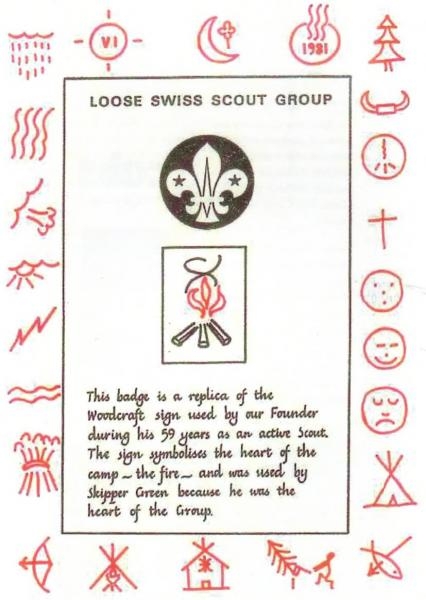
In The Beginning
When Jack Barcham Green was first approached in 1908 by a group of boys to start up the new game of “scouting”, the current organisation of scouting did not exist in any recognisable form.
Groups of boys (known as patrols) met in small shelters and sheds with little or no organisation or rules. As scouting became more organised, warrants for leaders were introduced. Jack Barcham Green’s first warrant was dated 1910 and was signed by Baden Powell.
It must be born in mind that at this time there were very few cars, the main form of transport still being the horse. Very few houses even had electricity. Jack Barcham Green was the son of local paper maker and lived in the Godlands at Tovil (now the fire HQ). Later JB (as Jack Barcham Green was known) ran the paper business at Hayle Mill.
When he married a few years later, he moved to Loose living in a number of houses in the area. When the scouts were first registered in 1913 the group was known as 11th Central Kent. You will see from JB’s memories of the group, how he recalls the start of scouting in Loose.
The following is an extract from the history of the group written by JB in which he sets out how the group first started in 1908 and how it developed over the first few years. The full document is several pages long and details much of the group’s history up to the date it was written.
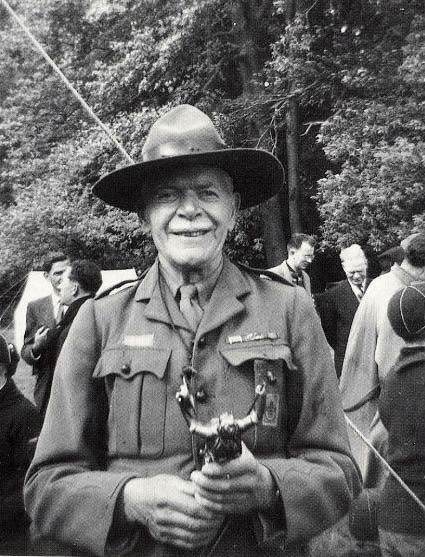
Brief History of the Loose Troop Extract
In the early summer of 1908 boys in Loose came to me and said they wanted to be Scouts and asked me to help them start a Troop. On the declaration of war in 1914 I received orders to take the troop to Dover. We took over a patrol on the road from Dover Castle and Martin Hill. By March 1915 six Scouts of the Loose Swiss Troop had taken over on Coast Guard duty at Birchington, where they patrolled the beaches and looked for mines etc. I joined the army in 1916 but continued to have the Troop log sent to me by post.
On 7th August 1937 we had another camp in Belgium, we camped for about a week in the Ardenne Mountains. There were 4 Rovers, 4 PLs, 2 Scouts and 1 Belgian Rover. We were meeting at the Old School at this period, and had a church parade every month with attendance of about 40.
From December 1940 to April 1945, 95 badges were won in the Troop spite of the fact that I had home guard duties and no A.S.M. This was due to fine by work by the PLs….
More important than all these activities is the help that the Scouters have tried to give to the development by the Scouts of their own characters. We have tried to show each Scout who has passed through the troop that he has the power to strengthen his own character. We have shown the way and lent him a hand. I think that will be more use to them in later life that knowing how to tie a bowline, but we tried to teach them both.
1910 to 1920
This period of time was perhaps one of the best recorded in the Group’s history. It covers the First World War and the activities of the Group members including the loss of two leaders killed in action. Troop log books of this period, the earliest log book being dated 1913, are still in the Group archives at the HQ. These log books had entries written by both boys and leaders and were constantly posted around the battle field from one leader to another. The following article from this period is typical of it’s time and relates to the period spent on coastal watch at Birchington where boys of 14-16 years of age spent months at a time on war work watching for ships and boats in the channel.
During this period, the age of scouts seemed to be from around 12-18 years old, but not clearly defined. It was during this period that the Cub sections were started for the younger boys from 8 years upwards.
The following is an extract from the troop log book covering the period from November 1914 to August 1915 which is the early part of the First World War. The article written by PL B Antrum on 3 July 1915 details the activities of the boys on coastal watch at Birchington.
1915 Log Book Extract
Having been home on leave a short time ago I was very glad to see the old place again and see the TASM (Troop Assistant Scout Master) and he told me he was getting on alright managing the troop although sine gave had to be suspended (bad business). We were very glad to see Willie down here the other day. We go in bathing every day now and have a swim which we all can do with the exception of “Pat” who is picking it up. My mate has gone home on leave so I have some extra work to do.
I am writing this in the dark so you must excuse the bad writing. We have had two cakes given to us today so we had an extra tea on the strength of them. We have got some fine gardens and gathered radishes from them the other day for tea and we have got any amount of vegetables coming on. I think Mr Foulkes piece is top hole and I will have a try at the competition he has drawn up
Allan and I slept out for a lark last night and when we got back we found the rest sleeping away owing to Mr Green having not set the alarm. It was very lucky it did not rain last night or we should have got wet which would not be very “comfy”.
Good bye and good luck.
1920 to 1930
Not many records exist for these years, in fact it is believed that the scouts may have closed for a period, although cubs appear to have kept going. JB’s memories for this time are also a little thin. There is evidence of a camp in 1923 and further activities associated with major scouting events throughout the county.
This period of history after the First World War was a time when the country was in a financially poor state and the recession of 1929 meant that many families were very poor. Few cars were on the roads and very few houses had electricity installed.
In 1921, a memorial was unveiled at Crisbook Mill to two members of Loose Scouts killed during the First World War; it can still be seen today close to the old mill building.
Rover scouting for those over 18 years old was in full swing by 1930 as the log books show.
The following article is a partial record of a camp at Rye in 1923. The author is unknown but details of some of the enjoyment, mainly eating and drinking, of boys in the troop at that time.
1923 Camping at Rye
Loose Swiss Scouts, Glad Bincham (Scout Master) assistant S.Ford, Whale GFG Brett took the scouts to camp at Rye. Mrs.Brett cooked 60 eggs in a field kitchen for breakfast. It rained heavily preventing drinking water being fetched from the local house so rain water was collected in tarpaulin sheet – which was then strained through a cloth and lemonade crystals added – boys were thrilled to drink it.
Meanwhile Mrs.Brett made pastry on paper on a bench – again boys thought the jam tarts were very nice. I cannot recall any other incident except the wives of assistant scout masters all helped in camp – I don’t recall who enjoyed camp the most.
1930 to 1940
Over this period of time, scouting at Loose appears to have been very active with numerous recorded events including a trip to Bruges in Belgium on bicycles. Also, many camps including county events, along with a variety of training courses for leaders are recorded. From the earliest days, leaders were known as Scout Masters and Assistant Scout Masters, with JB being the Group Scout Master. These titles were changed with the re-organisation of the 1960’s.
Build up to the Second World War towards the end of the decade meant that many people were involved with the war effort with Rover Scouts being called up into the forces. The group had, since its formation, never had its own headquarters but had met in a number of locations around the area.
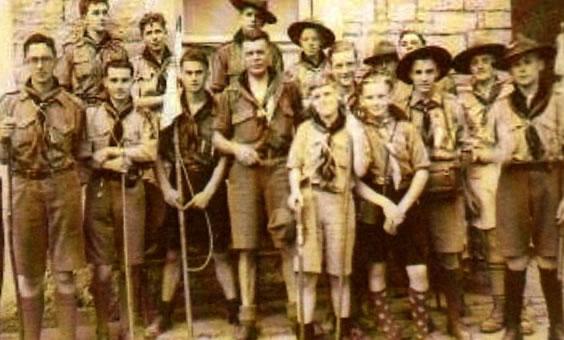
The following article is taken from the troop log covering the period 1938 – 1941. This article written by “Bosun” of the Owls shows the enthusiasm of Scouts and in particular, the regular trip to the swimming baths in Maidstone.
1939 Log Book Extracts
This being the first time I have written in this log book makes the proud to think that my brother scouts have also written in this log book. Now I am going to tell as an Owl some of the learning in our six months career as a scout. We first started learning our Law and Promise etc then we started out swimming at Maidstone Baths, after the baths we usually have a frolicy time with Skipper on the wreck, we also have our rations of the ships biscuits, after we have had our fun we finish scouts for another day. Scouts is a nice thing for a boy, he is made a better boy altogether, as you have heard above that we are swimming, three can swim including myself.
Bosun, Owls
1940 to 1950
Numerous activities were curtailed during the war but the cubs and scouts kept going. The most important of the events during this period was the purchase of our own headquarters in Pickering Street for the princely sum of £125 in 1941. Funds were raised and the collection of old timber farm buildings was purchased. Part of the buildings had been used as a jam factory. The original buildings have substantially disappeared and been replaced with more permanent buildings. The only remaining part of the original buildings is the timber building on the north side containing the Scouter’s room. The grassed yard has long since disappeared.
Following the war the group started to grow in strength and was becoming known for its high standard of scouting.
“Bob-a-job” week was a top fund raising activity of the time. Each scout went around the area from house to house offering to do jobs in return for payment of generally 1/-(one shilling known as a bob which now equates to 5p). The work often involved cleaning cars, gardening or other household chores. Bob-a-job was stopped in later years due to child protection and the fears associated with boys entering houses of unknown people.
In 1948, the group celebrated its 40th anniversary at headquarters in Pickering Street. On 26th June, preceeded by a church service at Loose Church, various activities culminated in a camp fire on Mr Day’s field. To commemorate the event, a souvenir programme was produced which contained a history of the activities over the 40 years.
The following extract covers the period from 1942-1947
Souvenir Programme Extract
1942 In January there were 20 scouts, but no A.S.M. and it was found necessary to cut down numbers. Our balance at the Bank was £26 0s 0d, and our place of meeting was a garage on Old Loose Hill. In January we purchased the freehold of our new HQ in Pickering Street for £125 and moved in. The total cost, including repairs was approx £300, of which sum £62 10s 0d was contributed by Scout HQ in London
1943 Being in the Home Guard I left the PL’s to run the troop. Attendance was excellent and much good scouting was done. The Chief Scout, Lord Somers, visited the camp at Tovil and signed out log.
1944 In January A.S.M Wright was called up for the mines. This left me on my own again…. On 27th March we enjoyed a fine Easter camp at Chart Sutton, with much bathing and frying of eggs and sausages. On 14th June the Germans shelled Old Tovil Road and Hayle Road. Three Loose Scouts were camping at Tovil on 17th June during a “dog fight” overhead. Tadder found a piece of shrapnel two feet from his pillow. A flying bomb fell in Lancet Lane on 27th August. I was away on a Wood Badge course but the troop did splendid work. One patrol worked for five hours clearing debris from shattered houses. A night hike was carried out on 2nd December and Peter Latter gained much esteem by reporting that the sausages were sizzling at 12.30am.
1950 to 1960
By now the group was growing from strength to strength with new leaders taking on more roles within the group. Scouting was now a well established world wide organisation which in 1957 celebrated its 50 years with a large World Jamboree at Sutton Coalfield.
In 1958 the group celebrated its 50th anniversary with a camp and a service of dedication. Some scout members of the group at that time are still members today. Notably John Beeching, our Quarter-master.
The first person to have his name recorded as a Queen’s scout on the shields over the fireplace in the unit room was Roger Dickenson in 1953. Since then, over 35 other names have been proudly added to the display.
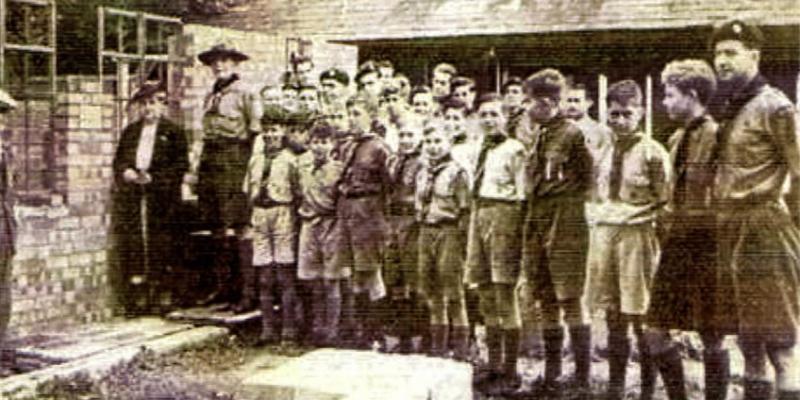
To celebrate 50 years, a camp was helped to commemorate the event. The 50 years was know as WAF YOTY (We are fifty years old this year). The article below was written by Jack Barcham Green of the camp in 1958.
1958: 50th Anniversary Celebration
The Loose Swiss Scout Group helped a WAF YOTY at Linton Park on Saturday 5th June, 1958 and a thanksgiving service at Loose Church on Sunday 8th June. The name of the meeting is derived from the Anglo-Saxon “We are fifty years old this year”
Fifty years is a long time and it is just fifty years ago that a gang of boys asked me if I could find them a place to meet so that they could start a scout troop. I found them a fir tree under which to meet and later persuaded Mr Joseph Barker to let us use his stables. These boys laid the foundation good and firm and thanks to the keenness of subsequent scouts and scouters, the Troop is still running
The WAF YOTY started with a cold wet morning but no rain fell on Saturday afternoon or Sunday morning. The troop camped at Linton Park for the weekend and erected a number of tents and a marquee on Friday night in a cold wind, plus rain. The flag was broken at 2pm and during the afternoon many old scouts, parents and friends of the troop visited the camp and swapped yarns. Harold Bennett was there from Gravesend. He was a PL in the Troop in 1908. R. Goodwin who was in the troop in 1909 was there, also Sid Rayner representing those who were in the troop in 1910, and it went on all the afternoon and some were quite surprised if I did not recognise them immediately!
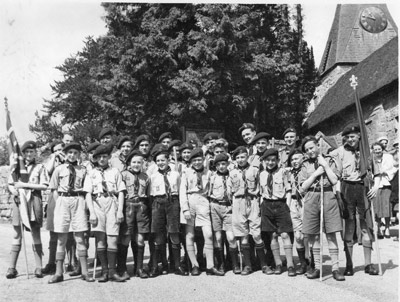
The DC and the District secretary attended and gave their congratulations to the group.
During the afternoon W. Quinnell the SM presented me with a magnificent statuette of a scout with a very nice inscription. This came as a complete surprise and I had difficulty in finding suitable words of thanks.
At about 7.30pm the camp fire was duly opened with our usual ceremony and a number of songs and gags followed each other quickly much to the joy of the many old scouts round the fire who had not forgotten the complicated wording of some of the songs. To close the camp fire we had three very soft “Izzykaas” for the founder of scouting.
Long after the parents had gone home there were small knots of men who kept saying ‘do you remember…’. This went on so late that some of them slept the night in camp.
The scout service was excellently planned and carried out by the Vicar of Loose who us a first class short scouty talk. Over 40 present members of the group attended and about the same number of old scouts and friends.
JBG GSM
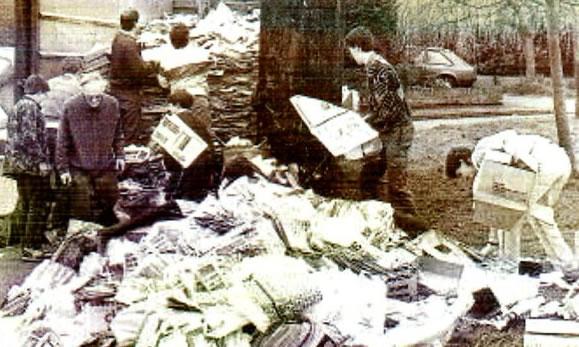
1960 to 1970
Up to now Loose had been a small village on the outskirts of Maidstone. During the 1960’s major housing developments in the area of south Maidstone meant a large increase in the population of the area. The group increased in size and support which meant that some of the existing buildings could be demolished and the new troop room was built.
The times were changing and the scout association also made major changes to the organisation. Rover and Senior scouts were replaced with Venture scouts. Out went the shorts and big hats. New test work programmes and activities were introduced.
By now houses had both electricity and gas. TV was common place in many homes and most homes had cars, fridges and other modern domestic appliances now taken for granted. Times had changed considerably since the early days and scouting had to change to keep pace with modern life. Camping and outdoor activities still remained the most popular of scouting activities and regular camps were held during this period.
Not only did scouts keep log books, but the cubs also. The article below was written by David Barker and clearly records the first day of cub camp at Linton Park on Saturday 30th August 1969.
1969 Log Book Extract
Loose Swiss Cub Camp 30/8 – 1/9 1969
On Sat 30th August 1969 at 10am we met at HQ where we were to be taken to Linton Park for our annual cub camp. We arrived at 10.30 and from that time to 1 o’clock we were unpacking, fetching wood and water.
At 1 o’clock we had dinner. Blue six did the washing up. At about 2.30 we had Muster, Grand Howl and the official opening. In the middle of the Grand Howl, Mrs Daubeny came up to say that the pool had been specially heated and that we could use it Saturday, Sunday and Monday.
After the official opening we had a game of long ball. At 3.15 we were sent to make camps for the zulu fight which took place the next day. At 4.15 we helped make the tea and collect more firewood.
At 6 o’clock we had tea and red six washed up. When the washing up had been done we went for a walk that ended up at Mr and Mrs Daubeny’s house where we went for a swim.
At 7.30 we had a camp fire, a drink of cocoa then bed.
David Barker
1970 to 1980
The expansion of the housing in the area in the 1960’s fed through to an increase in the number of boys looking to join the scouts. An upsurge in the number of boys and the associated support meant that further expansion of the HQ took place in 1976 with the erection of the two storey building.
This new building contained patrol rooms, stores, unit room, toilets and a cub room. The committee room originally included was later divided up into more patrol rooms.
A scouting magazine was started by the group in 1970 as a quarterly event, copies of the original still exist, so our current newsletter is not new.
As a fund raiser, waste paper collections were started in 1973 and a total collection for that year is recorded as 7.64 tons. In comparison the current yearly average collection is in the region of 200 tonnes.
The following article is taken from the first edition of “The Scouting Magazine” produced by Loose Swiss in 1970.
1970: Summer Camp
Tony Davis SPL, in submitting this report writes “I would like to express the groups thanks to the seriously overworked scouters for all their work at the camp”.
August 1st was a warm sunny morning as at 8am we started from HQ for South Wales. The advance party – Oz, Tim Little, Willy Holt and myself with Ventures Martin Keable and Grady Bailey set off – the back of the car scraping the road! Eight hours later Maes-y-beran Farm near Abergavenny was graced by our presence.
In Scouting tradition, we had a brew up and discussed the possibility of the kit not arriving. It did arrive however and we waded through tents, poles, spades, ropes and miscellaneous objects.
On Monday the rest arrived. 59 scouts, 8 Ventures, the Bailey family, Jess, Leila and Audrey. Tuesday afternoon was used to acclimatise everybody by sending them on a hike to explore the valley.
On Wednesday, pony trekking got off to an impromptu start (as this had been arranged for Thursday). Assigned activities including two patrols going to Abergavenny, orienteering exercises and canoeing for the ventures.
The patrol competition including the building of aerial runways, damming a stream, making a patrol swimming area, a ducking stool and the most unusual hike. Also carving woggles and baking cakes and pies. Camp fires were the real get-together run mainly by Willy Holt and myself aided and abetted by Oz as camp fire leader in chief. At the final camp fire 3 E’s toggles and pennants were handed out the eligible and in particular THANKS yells to those who had helped-the farmer and his wife, the Baileys who worked very hard and the scouters.
Many badges were hard earned, Tim Little and I went out on a mountaineers badge hike – a 3 day forty mile hike across the black mountains.
The main excursion was to brecon for souvenir buying. The last two days were spent clearing up, striking tents, packing kit. The coach left at midday on Friday 14th – typically the advance party left an hour and a half later.
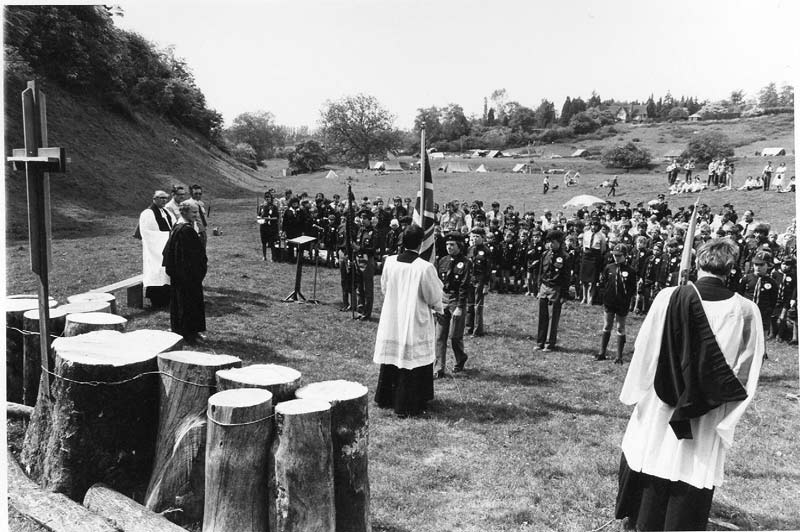
1980 to 1990
The major event of the 1980’s was the purchase of an area of land in the upper Loose valley from Joan Foster-Clark.
The opportunity arose in 1981 to purchase 40 acres of the valley to the east of Salts pond through to bottlescrew hill. The area contained 4 ponds, woodland, grazing land and a quarry, all to be used as a camp site and activity area.
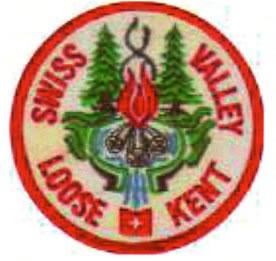
After discussion it was agreed that the group would attempt to raise the £25,000 asking price in the time required. This was achieved by various means and much hard work which is well documented in the history of the group “Never Give Up” written by Molly Proctor in 1992. The site was dedicated in May 1982 and became known as Swiss Valley.
This was only the beginning of the hard work and throughout most of the 1980’s much work was done including rebuilding of the weir to heron pond. The storm of 1987 severely damaged much of the woodland and even today there is still work needed to maintain the land and replant some of the areas.
Whilst the work on the land took up much time, the group was growing to its largest size ever. Fortunately the scouter team also grew in size and towards the end of the 1980’s the group consisted of 9 sections all operating from the HQ. 2 Beaver colonies, 2 Cub packs, 3 Scout troops and 2 Venture units. Very active support from parents and the supporters committee enabled the group to be adequately funded through this time.
The group were able to produce gang shows called “A Show of Our Own” every two years.
During the Armenian earthquake in 1988 the group managed to collect, sort, pack and ship out a lorry loaded with blankets to support the appeal.
1981: Rebuilding the Weir
Following the purchase of Swiss Valley in 1981, much repair was needed to the ponds. In particular the weir and sheep dip to Heron pond needed completely rebuilding. The work took over a year and to record 3600 hours were spent and many donations received, a small book titled “A Year on the Weir” was written.
Next came the problem of how to stop the water flowing whilst work was in progress. A number of ideas were proposed, from pumping the stream over the retaining wall, to putting a temporary pipe from a dam upstream and running this through the existing culvert. The latter would mean working around the pipe all the time – not a good idea but it seemed the only solution. It would really be much easier if the stream were not there at all, but in order to divert it through some 5 meters of edge slit 2 metres deep, 300mm of bricking retaining wall and some 70 metres of blue clay on average 2 metres deep on the other side of the wall, we would require something more substantial than picks and shovels.
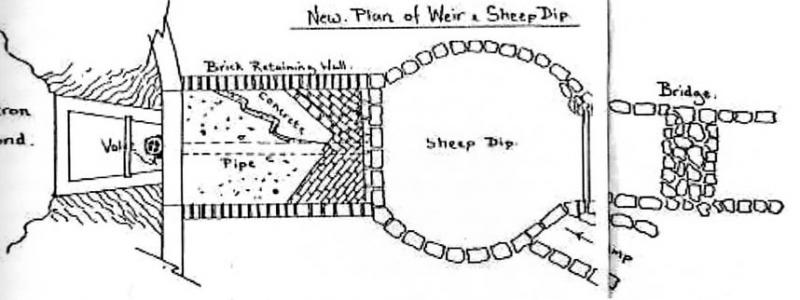
Plan for the new Weir & Sheep Dip
It was at this point that the contact in the Medway salvage company proved to be an advantage. They were prepared to carry out the excavation for us with their JCB when it was idle and were also willing to provide a 225mm plastic pipe for the new culvert and a gate valve. We couldn’t believe our luck! Another major decision was made – a bypass would be dug.
April 1st saw the initial start to the project, but some three weeks later the JCB had broken down so we began to dig by hand. We made fair progress but blue clay mixed with ragstone of massive size is a little daunting for a pick and shovel, even though they may be powered with enthusiasm. However the next weekend the JCB was repaired and the bypass was dug out in a matter of hours.
The thing that it couldnt do was knock a hole in the brick wall. This was done by hand and the stream was finally diverted at the end of may. The deepest parts of the new channel had to be shored up in case of wet weather or possible caving in – the sides were vertical.
Work could now begin on the clearing of the mud, blue clay, ragstone & concrete that lay in the old stream bed.
Why Swiss?
Finally, why Swiss? There is a certain amount of speculation in view of the original name of the troop as 11th Central Kent. It would appear that one of the original patrols was called Swiss Troop as early as 1913. It is a

